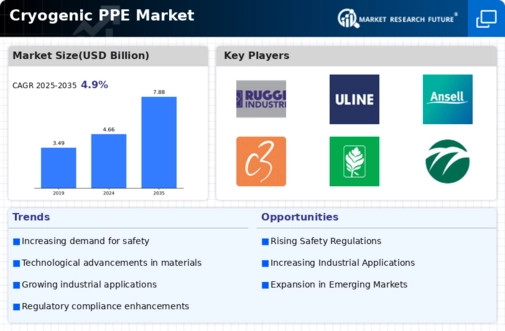Expansion of Industrial Applications
The Cryogenic PPE Market is benefiting from the expansion of industrial applications that utilize cryogenic technologies. Industries such as aerospace, energy, and manufacturing are increasingly adopting cryogenic processes for various purposes, including material testing and storage. This expansion necessitates the use of specialized PPE to protect workers from the risks associated with handling cryogenic substances. As these industries grow and evolve, the demand for effective protective equipment is likely to increase. Market data suggests that the aerospace sector, in particular, is projected to see substantial growth, driving the need for advanced cryogenic PPE solutions. This trend indicates a promising outlook for the Cryogenic PPE Market, as manufacturers adapt their offerings to meet the evolving needs of diverse industrial applications.
Technological Innovations in Cryogenic PPE
The Cryogenic PPE Market is experiencing a surge in technological innovations that enhance the performance and safety of personal protective equipment. Advanced materials, such as high-performance polymers and composites, are being developed to withstand extreme temperatures and provide superior insulation. These innovations not only improve the durability of the equipment but also increase comfort for the wearer. For instance, the introduction of breathable fabrics allows for better moisture management, which is crucial in cryogenic environments. As a result, manufacturers are investing heavily in research and development to create cutting-edge solutions that meet the stringent demands of various industries. This trend is likely to drive growth in the Cryogenic PPE Market, as companies seek to adopt the latest technologies to ensure worker safety and compliance with industry standards.
Increased Focus on Worker Safety Regulations
The Cryogenic PPE Market is significantly influenced by the heightened focus on worker safety regulations across various sectors. Regulatory bodies are implementing stringent guidelines to ensure that personnel working in cryogenic environments are adequately protected from potential hazards. This regulatory landscape compels companies to invest in high-quality PPE that meets or exceeds safety standards. As organizations strive to comply with these regulations, the demand for reliable and effective cryogenic protective equipment is likely to rise. Furthermore, non-compliance can lead to severe penalties and increased liability, motivating businesses to prioritize safety measures. Consequently, this trend is expected to drive growth in the Cryogenic PPE Market, as companies seek to enhance their safety protocols and protect their workforce.
Growing Awareness of Environmental Sustainability
The Cryogenic PPE Market is increasingly influenced by the growing awareness of environmental sustainability among consumers and businesses. As organizations strive to reduce their carbon footprint and adopt eco-friendly practices, there is a rising demand for PPE that is not only effective but also environmentally responsible. Manufacturers are responding by developing cryogenic protective equipment using sustainable materials and processes, which aligns with the broader trend of corporate social responsibility. This shift towards sustainability is likely to attract environmentally conscious consumers and businesses, thereby expanding the market for cryogenic PPE. Furthermore, as regulations regarding environmental impact become more stringent, companies may be compelled to invest in sustainable PPE solutions, further driving growth in the Cryogenic PPE Market.
Rising Demand from Healthcare and Research Sectors
The Cryogenic PPE Market is witnessing a notable increase in demand from the healthcare and research sectors. As the use of cryogenic technologies expands in medical applications, such as cryopreservation and cryosurgery, the need for specialized protective equipment becomes paramount. Research institutions and laboratories that handle cryogenic materials require PPE that can effectively protect personnel from extreme cold and potential hazards. According to recent data, the healthcare sector is projected to account for a significant share of the Cryogenic PPE Market, driven by advancements in medical technologies and an increasing focus on safety protocols. This rising demand is expected to propel the growth of the market, as manufacturers respond by developing tailored solutions that cater to the specific needs of these sectors.

















Leave a Comment